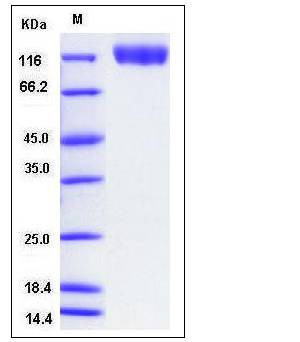Human VEGFR2 / Flk-1 / CD309 / KDR Protein (His Tag)
CD309,Flk-1,FLK1,VEGFR,VEGFR2
- 100ug (NPP4388) Please inquiry
| Catalog Number | P10012-H08H |
|---|---|
| Organism Species | Human |
| Host | Human Cells |
| Synonyms | CD309,Flk-1,FLK1,VEGFR,VEGFR2 |
| Molecular Weight | The secreted recombinant human VEGFR2 consists of 756 amino acids and predicts a molecular mass of 84.6 kDa. The apparent molecular mass of rhVEGFR2 is approximatly 120-130 in SDS-PAGE under reducing conditions. |
| predicted N | Ala 20 |
| SDS-PAGE |  |
| Purity | > 97 % as determined by SDS-PAGE |
| Protein Construction | A DNA sequence encoding the extracellular domain of human VEGFR2 (NP_002244.1) (Met 1-Glu 764) was fused with a polyhistidine tag at the C-terminus. |
| Bio-activity | 1. Using the Octet RED System,the affinity constant (Kd) of human VEGFR2-his bound to biotinylated human VEGF165 was 5.9nM. 2. Measured by its ability to inhibit the VEGF-dependent proliferation of human umbilical vein endothelial cells (HUVEC). The ED50 for this effect is typically 1-4 µg/mL in the presence of 10 ng/mL recombinant human VEGF165. |
| Research Area | Signaling |Signal Transduction |Protein Phosphorylation |Tyrosine Kinase |Receptor Tyrosine Kinases |
| Formulation | Lyophilized from sterile PBS, pH 7.4 1. Normally 5 % - 8 % trehalose, mannitol and 0.01% Tween80 are added as protectants before lyophilization. Specific concentrations are included in the hardcopy of COA. |
| Background | VEGFR2, also called as KDR or Flk-1, is identified as the receptor for VEGF and VEGFC and an early marker for endothelial cell progenitors, whose expression is restricted to endothelial cells in vivo. VEGFR2 was shown to be the primary signal transducer for angiogenesis and the development of pathological conditions such as cancer and diabetic retinopathy. It has been shown that VEGFR2 is expressed mainly in the endothelial cells, and the expression is upregulated in the tumor vasculature. Thus the inhibition of VEGFR2 activity and its downstream signaling are important targets for the treatment of diseases involving angiogenesis. VEGFR2 transduces the major signals for angiogenesis via its strong tyrosine kinase activity. However, unlike other representative tyrosine kinase receptors, VEGFR2 does not use the Ras pathway as a major downstream signaling but rather uses the phospholipase C-protein kinase C pathway to signal mitogen-activated protein (MAP)-kinase activation and DNA synthesis. VEGFR2 is a direct and major signal transducer for pathological angiogenesis, including cancer and diabetic retinopathy, in cooperation with many other signaling partners; thus, VEGFR2 and its downstream signaling appear to be critical targets for the suppression of these diseases. VEGF and VEGFR2-mediated survival signaling is critical to endothelial cell survival, maintenance of the vasculature and alveolar structure and regeneration of lung tissue. Reduced VEGF and VEGFR2 expression in emphysematous lungs has been linked to increased endothelial cell death and vascular regression. |
| Reference |
